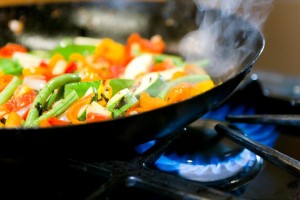 A long time ago women gathered in community or church kitchens and cooked together for holidays, canned preserves or pickles. The time consuming tasks were pleasantly endured thanks to the camaraderie. When people take cooking classes, they are not cooking in isolation but rather with other people with whom they can share the experience of cooking and share the food. Cooking classes help to restore the social aspect of cooking.
A long time ago women gathered in community or church kitchens and cooked together for holidays, canned preserves or pickles. The time consuming tasks were pleasantly endured thanks to the camaraderie. When people take cooking classes, they are not cooking in isolation but rather with other people with whom they can share the experience of cooking and share the food. Cooking classes help to restore the social aspect of cooking.
I have been teaching vegetarian cooking classes for over 25 years. The cooking class kitchen is my laboratory. A recipe is a canvas that I get to create every time I teach a cooking class. I always learn something from the students. I get to share my recipes with students and see how easy or difficult the steps are and how expensive the recipe is to prepare. Peoples’ food budgets vary and one needs to be sensitive to that.
A culinary instructor is an intimate profession. People let you know their food prejudices, likes/dislikes, and food sensitivities. You have the ability to come up with the perfect recipe that will take everyone’s needs into account. Many families need a recipe base from which to cook from and people take cooking classes because cooking is an investment of time and money. They want to know that the recipe can be easily prepared, delicious and affordable.
In my cooking classes, I demystify ingredients that do not normally have marketing boards promoting them. Take quinoa for example, there are many varieties to choose from and each has a different cooking time. When you buy your quinoa from bulk, there is no information on how long it takes to cook. Through my cooking classes, I depart valuable information that makes people feel more confident cooking quinoa and help people to avoid mistakes.
Cooking classes are fun, interactive, open up new culinary directions and helps you build on your previous knowledge.



